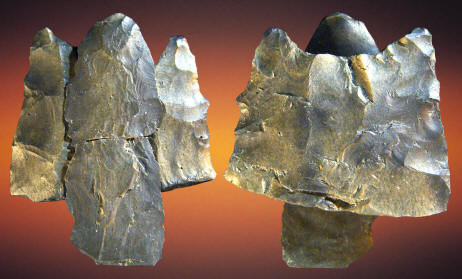|
FLUTED POINT BASE WITH
REFIT CHANNEL FLAKE
(TWO CASTS)
SUGARLOAF SITE
SOUTH DEERFIELD, MASSACHUSETTS
COPYRIGHT
MAY 31, 2014 PETER A. BOSTROM

2 CASTS ILLUSTRATED
CAST
#P-119
FLUTED POINT BASE WITH REFIT
CHANNEL FLAKE
(TWO CASTS)
SUGARLOAF SITE
SOUTH DEERFIELD, MASSACHUSETTS
by Richard Michael Gramly, PhD
Archaeological excavations
during 2013 at the monumental Sugarloaf Paleo-American encampment within
the Connecticut River valley, central Massachusetts focused upon the
“Ulrich Locus” –a manufacturing area of fluted points and bifacial
knives. This ancient workshop is one of six at the Sugarloaf site, and
it may have been used by knappers belonging to a single band of hunters.
At the Ulrich Locus 115 stone tools (including 23 fluted
points) were recovered along with 330 channel flakes and over 42,000
biface reduction flakes. Calcined bone from a hearth at this locus was
radiocarbon-dated to circa. 12,350 calendar years before present (Gramly
2014). Only 30-35% of this rich archaeological deposit was excavated;
much more awaits discovery.
The Sugarloaf knappers routinely made three varieties of
fluted points, (1) large lance tips, (2) small to medium-sized points
suitable for tipping javelins, and (3) flaring-sided knives. This basal
fragment (SLV-88) represents a fluted knife of the St. Louis style
(Perino 1985) that failed during or after the second face was fluted. It
was possible to reattach a collapsed channel flake (SLF-23 & SLV-99) to
the first face that was fluted.
Refitting of a channel flake to a fluted preform is
rare.
After breakage the fluted preform fragment was employed as a
wedge (piece esquillee).
|
